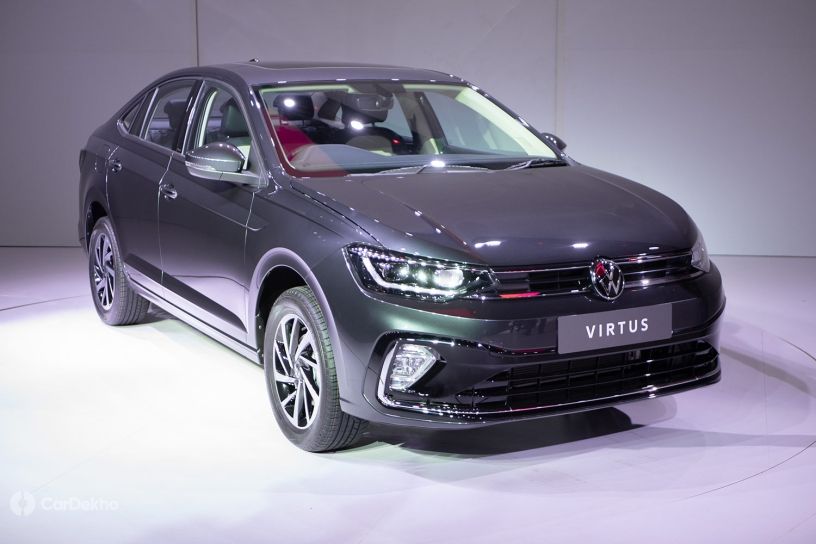Volkswagen Virtus Detailed In 25 Pictures
[ad_1]
The new sedan looks premium inside and the Performance Line variant gets additional sporty cosmetics

The Volkswagen Virtus has made its global premiere as the replacement for the Vento. It is larger and more premium than the aging sedan it replaces. While it shares its underpinnings with the recently launched Skoda Slavia, its exterior and interior is quite distinctive. It is due to be launched later in May. With the price reveal some time away, let’s take a closer look at the new compact sedan in the detailed gallery below:
Exterior
Front

The Virtus has a bold front end with a sizeable air dam that makes up most of the bumper. The grille with its chrome details is subtle and sleek, connecting the LED headlamps.

The front end of the Performance Line Virtus seems exactly the same except for the GT badge housed in the grille.

The LED headlight units have integrated L-shaped LED daytime running lights that run along the bottom and outside edge. The inside lamp is the one that doubles up as the turn indicator, while the outside lamp is the main headlight. It also gets halogen fog lamps housed in the corners of the sporty front bumper.
Rear

From the rear, the shared DNA between the Volkswagen Virtus and Skoda Slavia is easily noticeable. Like Skoda models, there is ‘Virtus’ lettering along the bottom edge of the boot with the ‘VW’ logo above the number plate. The bottom edge of the rear bumper is highlighted by a chrome strip that gives the otherwise flat shape an element of dynamism.

The sculpted shape of the boot arising from the rear fender and the way the LED taillamps wrap around give away their shared aspects. However, the Virtus gets distinctive split clear lens taillights that seem chunkier in design with a sporty Y-shaped light signature.

There is no difference in the shape of the rear end of the Virtus between the regular and GT-line variants.
Side
The side profile of the Virtus bears similarity with the Slavia as well but is easily distinguishable due to the distinctive design of the wraparound headlight and taillights on each sedan. Unladen, the rear end seems to be sticking up a bit high but that is a standard characteristic of cars in this segment. Overall, the Virtus looks fairly sporty from every angle and from the side, it is reminiscent of the Volkswagen Jetta as well.
While we’ve already seen both the Dynamic Line and Performance Line variants of the new Volkswagen Virtus, let’s compare some of the key visual differences between the two.
Dynamic Line vs Performance Line (GT)
Both get a shark fin antenna and a sunroof but the GT Line variant gets a contrast black roof unlike the Dynamic Line variant.
ORVMs and front fenders
The GT Line variant carries GT badging on the front fenders and contrasting black outside rearview mirrors. Meanwhile the Virtus Dynamic Line variants don’t get any fender badges and get body coloured ORVMs.
While the bootlid shape is sporty by default, Volkswagen adds a bootlip spoiler to the GT Line for extra sporty visuals.
The Virtus gets 16-inch alloys. While the Dynamic Line has a machined finish, the Performance Line GT variant gets special blacked-out alloy wheels with red brake calipers to match the sporty aesthetic.
Also read: Volkswagen Virtus: First Impressions
Interior
The interior of the Virtus looks familiar yet different. Its dashboard bears similarity to the Taigun compact SUV with its 10-inch central touchscreen infotainment system, the central AC vents below it, and the touch-based climate controls underneath them. This top-spec variant also features the digital instrument cluster. Volkswagen offers the Dynamic Line variants with a dual-tone black and beige cabin theme for the dash and upholstery, silver outlines on the dash and gloss black decor on the passenger side.

We got to see the automatic variants of the Virtus at its unveiling. The engine start-stop push-button is located just above the gear/drive selector while there are buttons to the right of it for the ventilated front seats. This top variant also features a wireless charging pad under the climate control panel with USB-C ports.

The Performance Line variant of the Volkswagen Virtus has the same layout but a different colour scheme. It gets all-black leatherette upholstery and the central console surrounds are finished in gloss black while most of the cabin still has a dual-tone black and beige theme. The red Virtus gets the added benefit of the dashboard featuring red striping instead of silver. It also seems to get a red themed digital driver’s display unlike the blue theme of the Dynamic Line Virtus.

The Virtus Performance Line also stands out with the housing for the engine start-stop button surround finished in red.
The Virtus offers adjustable headrests and three-point seatbelts for all seats. Seen in the pictures above is the all-black upholstery of the Performance Line variant.

It also offers rear AC vents with two more USB-C ports under them.
Engine

The Volkswagen Virtus is to be offered with the choice of two turbo-petrol engines: 1-litre TSI (115PS/178Nm) and 1.5-litre TSI (150PS/250Nm). The latter will be limited to the Performance Line variants. The smaller engine will be available with the choice of 6-speed manual and automatic transmissions while the more powerful engine gets the choice of a 6-speed manual and 7-speed DSG (dual-clutch automatic).
[ad_2]
Source link










